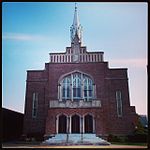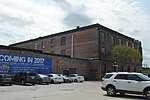West Point Cemetery (Norfolk, Virginia)

West Point Cemetery, also known as Potter's Field and Calvary Cemetery, is a historic cemetery and national historic district located at Norfolk, Virginia. It encompasses three contributing sites, one contributing structure, and one contributing object in an African American graveyard in downtown Norfolk. The cemetery was established in 1873, and includes a grouping of headstones marking the remains of 58 black soldiers and sailors who served in the American Civil War, and a monument honoring these veterans stands over their graves. Other notable elements include the Potter's Field, O’Rourke Mausoleum, and the West Point Cemetery entry sign.It was listed on the National Register of Historic Places in 2007. It is contiguous with Elmwood Cemetery, listed in 2013.
Excerpt from the Wikipedia article West Point Cemetery (Norfolk, Virginia) (License: CC BY-SA 3.0, Authors, Images).West Point Cemetery (Norfolk, Virginia)
East Princess Anne Road, Norfolk
Geographical coordinates (GPS) Address Nearby Places Show on map
Geographical coordinates (GPS)
| Latitude | Longitude |
|---|---|
| N 36.86 ° | E -76.284166666667 ° |
Address
East Princess Anne Road
East Princess Anne Road
23510 Norfolk
Virginia, United States
Open on Google Maps








